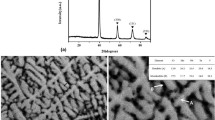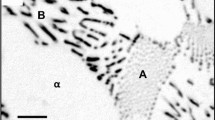Abstract
The deformation and fracture behavior of the Ta-8 wt pct W-2 wt pct Hf (T-111) alloy internally oxidized at 1273 K was studied at test temperatures up to 1589 K (2400°F). The results are discussed in terms of oxygen content, and the morphology of the oxide. Thermodynamic calculations based on lattice parameter measurements indicate that the oxygen solubility in T-111 is low, about 72 ppm at 1973 K. Beyond the solubility limit, oxygen reacts with hafnium to form hafnium oxide, which causes a continuous decrease in lattice parameter until all the hafnium has been removed from the solid solution. A homogeneous dispersion of fine, coherent hafnium-oxygen zones was observed in as-oxidized specimens. These zones coarsened upon annealing at or above 1673 K and eventually precipitated as rectangular HfO2 particles. Alteration of the oxygen distribution and oxide morphology by heat treatment resulted in large changes in the mechanical properties. For example, specimens aged 15 min at 1973 K showed little change up to 3500 ppm O, but above this level the yield strength increased and ductility decreased abruptly. Ductility was completely lost at 4200 ppm O, independent of test temperature. Specimens with no aging treatment other than oxygen addition lost all ductility at 800 ppm O. The structure and mechanical properties are correlated.
Similar content being viewed by others
References
J. H. Swisher: “Internal Oxidation,” inOxidation of Metals and Alloys, pp. 235–67 ASM, Metals Park, Ohio, 1970.
G. S. Ansell, T. D. Cooper, and F. V. Lenel, eds.:Oxidation Dispersion Strengthening, Proceedings of a Symposium Held at Bolton Landing, N.Y., June 1966, Gordon and Breach, New York, 1968.
E. Orowan: inSymposium on Internal Stresses in Metals and Alloys, p. 451, Institute of Metals, London, 1948.
G. S. Ansell: “The Mechanism of Dispersion Strengthening: A Review,” inOxidation Dispersion Strengthening, Proceedings of a Symposium Held at Bolton Landing, N.Y., June 1966, pp. 61–141, Gordon and Breach, New York, 1968.
M. F. Ashby:Phil. Mag. 1966, vol. 14, p. 1157.
E. N. Rhines, W. A. Johnson, and W. A. Anderson:Trans. AIME, 1942, vol. 147, p. 205.
E. Gregory and G. C. Smith:J. Inst. Metals, 1956–57, vol. 85, p. 81.
M. F. Ashby and R. M. A. Centamore:Acta Met., 1968, vol. 16, pp. 1081–92.
D. M. Williams and G. C. Smith: “A Study of Oxide Particles and Oxide-Matrix Interface in Copper,” inOxidation Dispersion Strengthening, Proceedings of a Symposium Held at Bolton Landing, N. Y., June 1966, pp. 509–36, Gordon and Breach, New York, 1968.
R. M. Bonesteel, D. J. Rowcliffe, and T. E. Tietz:Trans. Japan Inst. Metals, 1968, vol. 9, suppl., p. 597.
S. A. Bradford:Trans. TMS-AIME, 1964, vol. 230, p. 1400.
H. Inoye:Contamination of Refractory Metals by Residual Gases in Vaccum Below 10 −6 Torr, ORNL-3674, September 1964.
D. O. Hobson: “Aging Phenomena in Columbium-Base Alloys,” inHigh Temperature Materials, pp. 325–34, Interscience, New York, 1963.
J. R. Stewart, W. Lieberman, and G. H. Rowe: “Recovery and Recrystallization of Columbium-1.0% zirconium Alloy,” inColumbium Metallurgy, p. 407, Interscience, New York, 1960.
D. J. Rowcliffe, R. M. Bonesteel, and T. E. Tietz: “Strengthening of Niobium-Zirconium Alooys by Internal Oxidation,” inOxidation Dispersion Strengthening, Proceedings of Symposium Held at Bolton Landing, N. Y., June 1966, pp. 741–50, Gordon and Breach, New York, 1968.
J. B. Mitchell:Acta Met., 1971, vol. 19, p. 1063.
L. Brewer:Chem. Rev., 1953, vol. 52, p. 1.
D. R. Stoner:Determination of the Weldability and Elevated Temperature Stability of Refractory Metal Alloys, Final report, Task IV—The Effect of Contamination Level on the Weldability of Refractory Metal Alloys, WANLPR(P)-015, October 1969.
D. E. Etter and W. H. Smith:J. Less-Common Metals, 1972, vol. 27, p. 109.
H. Inouye: “Interactions of Refractory Metals with Active Gases in Vacua and Inert Gas Environments,” inRefractory Metal Alloys Metallurgy and Technology, I. Machlin, R. T. Begley, and E. D. Weisert, eds., pp. 165–95, Plenum Press, New York, 1968.
G. M. Wolten:J. Amer. Ceram. Soc., 1963, vol. 46, p. 418.
C. T. Liu, H. Inouye, and R. W. Carpenter:J. Less-Common Metals, 1971, vol. 25, pp. 123–29.
H. Braun and E. Rudy:Z. Metallk., 1960, vol. 51, p. 360.
R. W. Carpenter, C. T. Liu, and P. G. Marden:Met. Trans., 1971, vol. 2, pp. 125–31.
D. A. Vaughn, O. M. Stewart, and C. M. Schwartz:Trans. TMS-AIME, 1961, vol. 221, p. 937.
C. H. Schramm, P. Gordon, and A. R. Kaufmann:Trans. TMS-AIME, 1950, vol. 188, p. 196.
D. O. Hobson:Aging Phenomena in Columbium-Base Alloys, ORNL-3245, March 1962.
R. W. Buckman and R. L. Ammon: Westinghouse Astronuclear Laboratory, Pittsburgh, personal communication, May 1972.
R. W. Carpenter: “Transmission and Scanning Electron Microscope Observations of Niobium-Hafnium Alloys,” inElectron Microscopy and Structure of Materials, Proc. 5th Int. Materials Symp., Berkeley, Sept. 13–17, 1971, G. Thomas, R. M. Fulrath, and R. M. Fisher, eds., pp. 667–77, University of California Press, Berkeley, 1972.
P. N. T. Unwin and G. C. Smith:J. Inst. Metals, 1969, vol. 97, pp. 229–310.
K. D. Sheffler, J. C. Sawyer, and E. A. Steigerwald:Trans. ASM, 1969, vol. 62, p. 749.
D. Tabor:J. Inst. Metals, 1951, vol. 69, p. 1.
R. T. Begley, R. L. Ammon, and R. Stickler:Development of Niobium Base Alloys, WADC-TR-57-344, Part VI, February 1963.
C. T. Liu and J. Gurland:Trans. ASM, 1968, vol. 61, pp. 156–67.
K. E. Puttick:Phil. Mag., 1959, vol. 4, p. 964.
W. W. Platte:Welding J., 1963, vol. 42, pp. 69s-83s.
A. G. Ingram, M. W. Mallett, B. G. Koebe, E. S. Bartlett, and H. R. Ogden:Notch Sensitivity of Refractory Metals, ASD-TR-61-474, August 1961.
Author information
Authors and Affiliations
Additional information
This research was sponsored by the U.S. Atomic Energy Commission under contract with Union Carbide Corporation.
Rights and permissions
About this article
Cite this article
Liu, C.T., Inouye, H. & Carpenter, R.W. Structure and mechanical properties of internally oxidized Ta-8 Pct W-2 Pct Hf (T-111) alloy. Metall Trans 4, 1839–1850 (1973). https://doi.org/10.1007/BF02665411
Received:
Issue Date:
DOI: https://doi.org/10.1007/BF02665411




